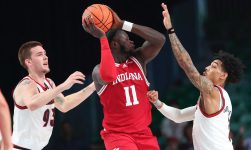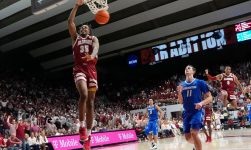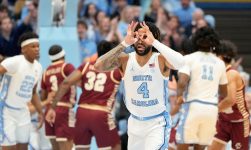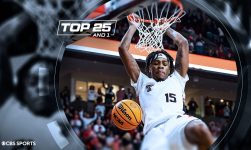Home teams won 59.9% of their games last season in college basketball, according to KenPom. That was up from 57.5% over the previous two seasons. Winning on the road in college basketball is tough, and that’s accounted for in the NCAA’s NET rankings formula, which rewards any victory over a team in the top 75 of the NET with the coveted “Quad 1” status.
But deciphering the precise strength of a team’s home-court advantage in college basketball is difficult because there are several factors to consider beyond just attendance and home winning percentage. How close are the students to the opposing bench? In some cases, altitude can be a factor. While some venues can prove incredibly raucous for certain marquee matchups, the intimidation factors tapers dramatically for unheralded opponents.
When Gary Parrish and Matt Norlander asked which arenas boast the best home-court environments to roughly 100 coaches during last year’s Candid Coaches series, 22 different schools appeared on at least three ballots. The survey showcased the diversity of thought around this topic. While programs such as Kansas and Duke led the way, some less predictable schools such as Wichita State and Texas Tech also fared well in the coaches’ rankings.
For this week’s Dribble Handoff, our writers are weighing in on the topic. Which college basketball venue brings the best peak home-court advantage in the sport? Here are our responses:
Kansas
The only proper way to start this list is with Allen Fieldhouse, the historic home of the Kansas Jayhawks. There’s no more special place in college basketball, and it’s my personal favorite.
Have you been there? If not — and if you can — you should try to get there someday because it truly should be a bucket-list type place for all hoop heads. The building is named after Phog Allen, otherwise known as the “Father of Basketball Coaching.” The court is named after Dr. James Naismith, the inventor of the game.
Hard to beat that combo.
Allen Fieldhouse has been the home of the Jayhawks since 1955. It looks cool. It sounds amazing. And it’s undeniably one of the best, if not the best, home-court advantages in the sport — especially since Bill Self replaced Roy Williams 20 seasons ago. Since then, the Jayhawks are 307-17 inside Allen Fieldhouse. In other words, Self has averaged fewer than one loss at home per season. And he’ll enter Year 21 at KU with the same number of Big 12 regular-season titles (17) as losses inside Allen Fieldhouse (17).
It’s been consistent excellence for two decades. Self is the biggest reason for the success. But the magic in the building matters. — Gary Parrish
The great thing about college basketball is that a story like this could include 20 gyms and it still wouldn’t quite fill up a list of truly the most intimidating and intoxicating environments in the sport. Purdue, for example, is unquestionably a top-10 barn in college hoops — but it’s not listed here today. I’ll go with the Kennel. I took this video on my trip there in 2021, and the video probably gets across 1/100th of what it felt like to be in that building that night.
Students in ridiculous costumes, overnight camping to get the best seats, big-time hype videos, coordinated cheers and crowd movement. They do it right up there in Spokane.
One huge thing Gonzaga’s home arena has going for it is the size. McCarthey Athletic Center holds approximately 6,000 people, which is just cozy enough to feel like an intimate environment but also large enough to feel like big-time college hoops. It’s one of the loudest arenas I’ve ever been in, and the student section situation is emphatic. Gonzaga is a powerhouse of a program tucked away in the Pacific Northwest, and thanks to two-plus decades of NCAA Tournament appearances, it also succeeds in getting almost every program of note to fly up there and play on its home turf.
How hard is it to beat Gonzaga at Gonzaga? Mark Few’s program has 23 home losses in the past 24 seasons. — Matt Norlander
How imposing can a place with a Razorback at center court and an arena filled with chants of “Woo Pig Sooie!” really be? If that’s your question about my selection of Arkansas here, then buddy, I’d wager there’s a 112% chance you haven’t experienced this place for yourself. For shame. Bud Walton Arena at the University of Arkansas is one of the most imposing environments in college basketball. Yes, there’s a literal feral pig serving as the mascot, and yes, the “Woo Pig Sooie!” chant — the hog call, it’s known — is an awkward squeal that might rival Lloyd Christmas’ all-time shriek. However, add in the feral pig with ferocious fans who live and breathe to squeal at their favorite team in an arena that reverberates in heated moments, and it’s easy to see why coach Eric Musselman and Arkansas have one of the most lethal home-court advantages not just in the SEC, but all of college sports. — Kyle Boone
Texas Tech
My colleagues covered the must-hit choices here, so I’ll lean into the best “peak” home-court advantage and go Texas Tech. You might not expect a venue with the unfortunate name of United Supermarkets Arena to pose much of a nuisance to visitors. But a trip to play the Red Raiders is anything but a stroll down the produce aisle, especially if your name is Chris Beard. When the former Texas Tech coach returned as the coach of Texas in the 2021-22 season, the scene amounted to a riot as the Red Raider faithful showed the fierce side of West Texas to a man they perceived as a traitor.
Beard was flanked by law enforcement throughout the day, and his team was no match for the seething, booing, merciless Red Raider faithful. Following a 77-64 win for the Red Raiders, then-coach Mark Adams said the fans “were maybe better than our players.” Texas Tech fans do not replicate that intensity with every home game, but their fever pitch is crippling for visitors. When the Red Raiders are good and their fanbase is inspired, the arena’s 15,300-seat capacity turns into a hornet’s nest.
There’s been no better display of home-court advantage in American sports in recent years than what we saw during Beard’s return. If new coach Grant McCasland can tap into that passion, it may provide a shock to the several new Big 12 members set to cycle through the league’s venues over the next few seasons. — David Cobb
Duke
Is there a more obvious choice than Cameron Indoor Stadium? Playing at Duke as the road team has to be one of the most intimidating atmospheres in all of sports. The sitting capacity of the arena is just over 9,000, which, compared to other venues in the ACC, is significantly smaller. For example, North Carolina’s gym (The Dean Smith Center) holds almost 22,000 people. The smaller venue and the limited capacity are what make it unique, however. Fans have a chance to be within the fingertips of opposing players because of their ability to sit right on the edge of press row and behind other media on the baseline.
Duke students camp out in “Krzyzewskiville” named after legendary coach Mike Krzyzewski, so they don’t miss out on the action. In Coach K’s final game against North Carolina in 2022, fans camped out for weeks in order to secure their spot. Duke is 832-154 (.844) all-time at the arena and went 474-59 (.889) at home under Coach K. Since the 2004-05 season, Duke is 179-12 at home; the only program that’s had more success at home during that stretch is Kansas. Watching a game at Duke is a bucket list item for any college basketball fan regardless of rooting interest — unless maybe you root for North Carolina. Even then, seeing that rivalry game up close in a loud and hostile environment is worth the trip. — Cameron Salerno






